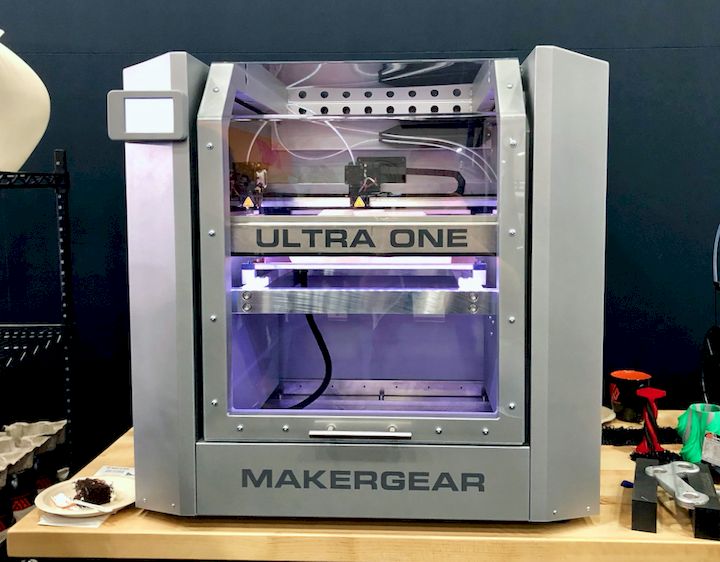![The MakerGear Ultra One 3D Printer [Source: Fabbaloo]](https://fabbaloo.com/wp-content/uploads/2020/05/image-asset_img_5eb095c7bc394.jpg)
We had a closer look at MakerGear’s new and powerful 3D printer, the Ultra One, their first industrial machine.
When looking at the massive metal bulk of the new Ultra One 3D printer from MakerGear, I could not help but contrast this device with the first models from the same company years ago. There’s quite a difference.
In fact, the company began as a supplier of, literally, “gear for makers”, including acrylic sheets and other materials. But by experimenting with a then-amazing-but-not-now MakerBot CupCake, the company realized it could do better and started production of first components, and then entire desktop 3D printers of its own.
MakerGear developed and released multiple devices through its lifetime, each more refined than its predecessor. Finally, this has culminated in the MakerGear Ultra One, which, according to CEO Rick Pollack, is “new from the ground up”.
MakerGear Ultra One Specifications
The shiny metal device, from its appearance, is utterly unlike anything we’ve seen previously from the company. This entirely enclosed machine boasts dual independent extruders (direct, non-Bowden), capable of 3D printing ABS, ASA, HIPS, Nylon, PET-G, PET-T, PLA, polycarbonate, polypropylene, BVOH, TPE, TPU, metal composites, wood composites, carbon fiber composites, and more and many more 1.75mm filaments.
The enclosure also ensures the machine is very quiet during operations. One item we don’t see on the list of features is any kind of air filtration system. If the machine were equipped with this, it might be more acceptable for office use. However, Pollack explained that there is an upgrade for a HEPA filter.
The build volume is a huge 406 x 356 x 330 mm, and you can halve the first number when the machine is in “Mimeo mode”, where the two extruders build copies of the same object simultaneously.
The build plate is borosilicate glass, and can be heated to a high 140C for great print adhesion of engineering materials. It can reach 110C in less than ten minutes, meaning startup times can be pretty decent. With all this heat in play, the maximum level the build chamber’s air can be maintained is 50C, very close to the temperatures used on much more expensive machines.
Where are the filament spools? They are stored inside the build chamber, allowing them to be pre-warmed and thus increasing print quality and reliability.
![The MakerGear Ultra One 3D Printer often requires a customized stand [Source: Fabbaloo]](https://fabbaloo.com/wp-content/uploads/2020/05/image-asset_img_5eb095c8390c6.jpg)
When testing the Ultra One, MakerGear discovered something unanticipated: the machine is too tall for a normal desktop installation. If placed on a standard desk, the lid will open too high for some to reach. Therefore, the company also introduced a specialized short platform to mount the Ultra One upon, as seen here.
MakerGear Ultra One Motion System
![Motion system frame of the MakerGear Ultra One 3D Printer [Source: Fabbaloo]](https://fabbaloo.com/wp-content/uploads/2020/05/image-asset_img_5eb095c89437f.jpg)
The key to the Ultra One is its all-new motion system. This is so impressive Pollack showed us a stripped-down version of the gantry system to demonstrate how smoothly it operates. The gantry is composed of:
-
The X gantry contains independent heads driven by fiberglass reinforced belts and guided by a precision linear rail.
-
Two precision linear rails guide the Y gantry, which is driven by two fiberglass reinforced belts.
-
Four 12mm rods guide Z motion independently driven by four lead screws.
We tested this ourselves and found the system to be almost effortless to move by hand. One can only assume the motor system would find the same. This gantry is also incredibly rigid, as you might imagine from the amount of metal in it. In fact, the entire system weighs 165lbs (75kg).
MakerGear Ultra One Video
Our friend Joel Telling has an interview with MakerGear’s Rick Pollack where the Ultra One is explored:
The MakerGear Ultra One system is available for US$12,500.
Via MakerGear











FELIXprinters has released a new bioprinter, the FELIX BIOprinter, which is quite a change for the long-time 3D printer manufacturer.